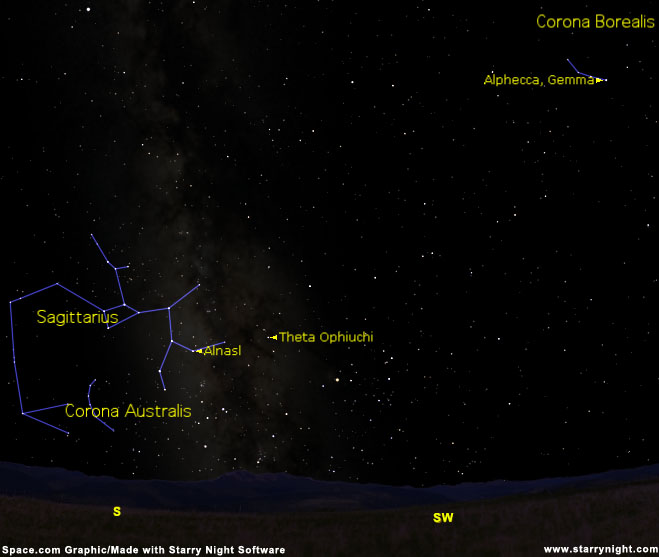
On these late summer evenings after the Sun has set, look low in the south for the classical Archer, Sagittarius.
Traditionally a centaur (half man, half horse), it's one of two such creatures in the sky. The other is Centaurus, a large, complex star pattern best viewed during the spring from far-southern localities. Long ago Sagittarius was not a centaur at all but simply a standing Archer (looking with some apprehension toward the Scorpion immediately to his west).
About two-fifths of the way up from the star Al Nasl northwest to Theta Ophiuchi lies the direction of the center of our Milky Way system, appearing as a veritable cloud of stars. The English poet John Milton (1608-1674) once wrote of the Milky Way as a "broad and ample road whose dust is gold and pavement stars." This is "Our Galaxy," to be spoken with pride, just as we would say, "My house." Via Lactea is the Latin for our star system's appearance in the sky. For the same reason, the Greeks used gala and kyklos, meaning milk and circle - hence our word galaxy.
Although tracing out an Archer-Centaur among Sagittarius' stars does require some imagination, visualizing it as a Teapot is quite easy. In fact, it is the Teapot and not the Archer that is portrayed on most star charts and in observing guides. I myself find it a truly delightful pattern: as star pictures go it's one of the best. More than a quarter century ago, the late astronomy popularizer, George Lovi (1939-1993) pointed out that we could augment our tea service with a teaspoon and lemon as well!
Lovi's teaspoon comprises stars in northern Sagittarius, while his lemon is an alternate rendition of the striking, albeit faint constellation of Corona Australis, the Southern Crown.
Now would also be a good time to make comparisons of the Southern Crown with its northern counterpart, Corona Borealis, located high in the west.
The main difference between the two is that the southern one is a fainter and tighter pattern; its brightest members are only of 4th magnitude (on this inverted scale, the dimmest stars visible to the naked eye are about magnitude 6.5). The brightest star of Corona Borealis, on the other hand, is 2nd-magnitude Alphecca.
Get the Space.com Newsletter
Breaking space news, the latest updates on rocket launches, skywatching events and more!
Unfortunately, for most of the United States, the Southern Crown is quite close to the horizon; from New York it barely gets 10 degrees above the horizon, where horizon haze becomes significant. One has to go as far south as Florida or the Gulf Coast to get a really good view of it.
Both crowns are ancient constellations, part of Claudius Ptolemy's (roughly 87-150 AD) "definitive" list of 48 groupings that were handed down to Western peoples from that era. Corona Borealis is the gem-studded golden crown of Ariadne, who, in Greek legend, received it from Bacchus upon marrying him.
Corona Australis was originally a group that represented a crown of leaves sometimes worn by the ancients on ceremonial occasions. The Southern Crown, however, has no particular story associated with it, although some write that it was another crown that Bacchus gave as a gift, this one to his mother Semele.
- Full Moon Fever
- Astrophotography 101
- Sky Calendar & Moon Phases
- 10 Steps to Rewarding Stargazing
- Understanding the Ecliptic and the Zodiac
- False Dawn: All about the Zodiacal Light
- Reading Weather in the Sun, Moon and Stars
- How and Why the Night Sky Changes with the Seasons
- Night Sky Main Page: More Skywatching News & Features

| DEFINITIONS |
Degrees measure apparent sizes of objects or distances in the sky, as seen from our vantage point. The Moon is one-half degree in width. The width of your fist held at arm's length is about 10 degrees. 1 AU, or astronomical unit, is the distance from the Sun to Earth, or about 93 million miles. Magnitude is the standard by which astronomers measure the apparent brightness of objects that appear in the sky. The lower the number, the brighter the object. The brightest stars in the sky are categorized as zero or first magnitude. Negative magnitudes are reserved for the most brilliant objects: the brightest star is Sirius (-1.4); the full Moon is -12.7; the Sun is -26.7. The faintest stars visible under dark skies are around +6. |
Join our Space Forums to keep talking space on the latest missions, night sky and more! And if you have a news tip, correction or comment, let us know at: community@space.com.

Joe Rao is Space.com's skywatching columnist, as well as a veteran meteorologist and eclipse chaser who also serves as an instructor and guest lecturer at New York's Hayden Planetarium. He writes about astronomy for Natural History magazine, Sky & Telescope and other publications. Joe is an 8-time Emmy-nominated meteorologist who served the Putnam Valley region of New York for over 21 years. You can find him on Twitter and YouTube tracking lunar and solar eclipses, meteor showers and more. To find out Joe's latest project, visit him on Twitter.









